Hardy Silex
Moderator: Ken M 44
Re: Hardy Silex
#21That is a lovely Multiplier drbaits and at 2 3/4 is smallest I,ve heard of,love the oil tube and a gem to have. Thanks for looking in your library Steen ,I don,t have many Hardys and so have few books about them . I wish I had written down where the printout I have was from although it seems to contradict Drewett book.I,ve googled some but haven,t found anything more.
As too Fefferje original post I found this post from years ago where Stuart gave a spin casting instruction but PB pictures don,t work anymore but written bit still there.
viewtopic.php?f=69&t=62856&p=540411#p540411
Thanks all. Daryl
As too Fefferje original post I found this post from years ago where Stuart gave a spin casting instruction but PB pictures don,t work anymore but written bit still there.
viewtopic.php?f=69&t=62856&p=540411#p540411
Thanks all. Daryl
-
Mole-Patrol
- Sport
- Posts: 72
- Joined: 03/17/20 11:41
Re: Hardy Silex
#22Forgive me if this has been covered before, but the Silex Major and any similar models can be easily converted to left hand wind. You can also modify the casting brake to make it a fighting drag.oddsnrods wrote:The Hardy Silex reels were made in various incarnations by Hardy between the late 1880's and the early 1990. They were designed to cast artificial 'baits' directly off the drum of the reel, similar to modern baitcast/ multiplier reels, indeed some Silex's were designed to be used on top of the rod in similar fashion.
The long rod used would have had the reel positioned lower down the handle, similar to spey casting set-up. The reel would have been adjusted to the weight of the bait (as baitcaster reel) and swung out without touching the reel as the small felt pad inside acted like light finger pressure to prevent over-run.
The reels had very delicate mechanisims and lightweight spools or drums.
Silex reels could and have been used for spey type fly fishing, in larger sizes or with shooting heads, most models would have been 3 3/4" or 4", mostly too large for single handed rods. They are also mostly, or all, right hand wind and their one way check prevents them being turned for left hand wind. The casting handle on the back of Silex's from the 20's on could catch loose fly line possibly.
The mecanism is a type of 'drag' used as a fly reel, however, although I have an example of each of the several freshwater models , apart from the Jewell, I would not think they would be appropriate for most fly fishing applications, apart from possible double handed as mentioned.
Malcolm
Models shown are the first incarnations. 1898 and 1910 models, jewelled bearing and very free spinning. Drewett mentions in his book each would have taken about a day and a half to make , in this case by Walter Dingly himself who designed the original Silex mechanism while at Hardys. No felt pads here, the brass 'shoe' would have been perfectly fitted on a black wheel attached to the inside of the drum, made probably of the very hard wood 'lignum vitae', so durable and hard it was used as bearings on Victorian water (as in navigation) locks. The results is a very smooth and sensitive casting regulator.
Regards,
Clive
I walk the paths where no one goes and cast to fish nobody knows
Clive
I walk the paths where no one goes and cast to fish nobody knows
-
Mole-Patrol
- Sport
- Posts: 72
- Joined: 03/17/20 11:41
Re: Hardy Silex
#24The one I have has three screws holding the check mechanism. It is best first to use a soft pencil to mark a line down the upper plate and down the brass drum that the brake shoe acts on. This is because the three holes might not be exactly 120 degrees apart and it makes it easier to re-assemble and less likely to bust a screw thread if the parts line up.
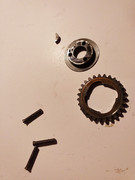
Remove the screws and put them safe. Then dismantle the check mechanism. Basically it is a cog with a small shaft key sat on top of a brass drum. Flip the cog over, replace the shaft key in the obvious place that it fits and re-assemble. I found it easier to re-assemble it upside down then invert it to replace the screws. Jut before I tightened the screws down I placed one drop of oil under the top plate to lubricate the shaft key.
The whole process takes around ten minutes unless you are also going to beef up the drag in which case you'll need to use the brass drum on the spindle to be able to measure the cable used to limit the spring.
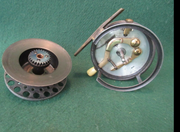
If you put the reel on your rod with the handles to the left you will have a check on the outward movement of line and the check should disengage within a quarter turn of the retrieve. Obviously the line will have to be re-spooled and the casting brake lever will be facing the front just under the fingers of your right hand.
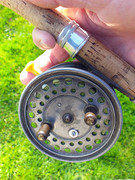
If you beef up the casting brake to a fighting drag first remove the felt pad which is the hardest part of the operation. Then fashion a new pad out of cork from a wine bottle. I made mine slightly larger in area than the felt pad and it stands about 2 or 3mm proud of the brass shoe the pad sits in. Effectively the pad is 'T' shaped but don't make it wider at the back or it will foul the check.
Then adjust the brake adjuster to around 75%of its travel. The cable I used was 15lb pike trace and I cut a crimp into two. The wire fits through the same holes as the spring. With one crimp fitted feed the wire through the two holes, manually using a finger apply the brake to its full extent with the cork pressing against the brass drum. Slide on the second piece of crimp tight on the end of the wire and against the hole and squeeze it tight using long nosed pliers. Now adjust the brake adjuster to 100% i.e. the strongest setting. That will allow you to put more pressure on the brake as the spring is limited in its stretch by the cable. Replace the drum in the check mechanism as described above.

I can get about 2lbs of pressure on my brake drag but the is all I need for its use. There is no reason why you cannot get a lot more drag if you need it.

Remove the screws and put them safe. Then dismantle the check mechanism. Basically it is a cog with a small shaft key sat on top of a brass drum. Flip the cog over, replace the shaft key in the obvious place that it fits and re-assemble. I found it easier to re-assemble it upside down then invert it to replace the screws. Jut before I tightened the screws down I placed one drop of oil under the top plate to lubricate the shaft key.
The whole process takes around ten minutes unless you are also going to beef up the drag in which case you'll need to use the brass drum on the spindle to be able to measure the cable used to limit the spring.

If you put the reel on your rod with the handles to the left you will have a check on the outward movement of line and the check should disengage within a quarter turn of the retrieve. Obviously the line will have to be re-spooled and the casting brake lever will be facing the front just under the fingers of your right hand.

If you beef up the casting brake to a fighting drag first remove the felt pad which is the hardest part of the operation. Then fashion a new pad out of cork from a wine bottle. I made mine slightly larger in area than the felt pad and it stands about 2 or 3mm proud of the brass shoe the pad sits in. Effectively the pad is 'T' shaped but don't make it wider at the back or it will foul the check.
Then adjust the brake adjuster to around 75%of its travel. The cable I used was 15lb pike trace and I cut a crimp into two. The wire fits through the same holes as the spring. With one crimp fitted feed the wire through the two holes, manually using a finger apply the brake to its full extent with the cork pressing against the brass drum. Slide on the second piece of crimp tight on the end of the wire and against the hole and squeeze it tight using long nosed pliers. Now adjust the brake adjuster to 100% i.e. the strongest setting. That will allow you to put more pressure on the brake as the spring is limited in its stretch by the cable. Replace the drum in the check mechanism as described above.

I can get about 2lbs of pressure on my brake drag but the is all I need for its use. There is no reason why you cannot get a lot more drag if you need it.
Regards,
Clive
I walk the paths where no one goes and cast to fish nobody knows
Clive
I walk the paths where no one goes and cast to fish nobody knows
Re: Hardy Silex
#25The Silex Major is the only Silex model without rim control, personally I would resist the temptation to doctor the casting mechanism to turn it into (in effect) an auxillary brake. Losing the felt pad may alter the value of the reel, although Majors tend not to demand high prices even in original condition.
I also toyed with the concept of turning Silex's around for l/hand wind. Easily done with first models, but at the end of the day Silex reels are best and look best, with the casting lever at the back. The Major can be easily braked using the tip of your finger inside the side of the drum/ spool if required.
One possible downside of double handled Silex's are those two handles ready to snag fly line when the rod is cast using the right hand, also I have found with 4" sizes or smaller those two handles are very close together making for a slow retrieve.
In any case, the Silex's are fine reels, and I am interested to find out how fly line can be cast off the reel at the end of a double handed spey style cast, as previous poster 60InchDV8 does with his wide Silex's.
One thing to note is that only larger/ wider Silex's (after the first model) have enough (plastic) fly line capacity, unless half lines are used as they were made for thinner silk spinning lines.
Malcolm
I also toyed with the concept of turning Silex's around for l/hand wind. Easily done with first models, but at the end of the day Silex reels are best and look best, with the casting lever at the back. The Major can be easily braked using the tip of your finger inside the side of the drum/ spool if required.
One possible downside of double handled Silex's are those two handles ready to snag fly line when the rod is cast using the right hand, also I have found with 4" sizes or smaller those two handles are very close together making for a slow retrieve.
In any case, the Silex's are fine reels, and I am interested to find out how fly line can be cast off the reel at the end of a double handed spey style cast, as previous poster 60InchDV8 does with his wide Silex's.
One thing to note is that only larger/ wider Silex's (after the first model) have enough (plastic) fly line capacity, unless half lines are used as they were made for thinner silk spinning lines.
Malcolm
-
Mole-Patrol
- Sport
- Posts: 72
- Joined: 03/17/20 11:41
Re: Hardy Silex
#26Whether the reel is "best" as a rhw surely depends on the angler? There have been many questions about converting Silex and other old reels to lhw over the years so perhaps not everybody agrees with you.
I use my reel for bait fishing for carp, barbel and catfish on rivers. It is possible to brake the reel using finger pressure on the rim, but it isn't easy and it can get quite hot if a catfish is encountered. The set up I have is far better to cast baits Wallis style or using a swing cast simply by controlling the brake with the second finger of my right hand during the cast. And it fits my grip better on a coarse fishing rod. For fly-fishing it might not suit the purpose.
As for it "looks right" whatever that means, with the lever at the back, and the change in value are immaterial. I don't buy reels as an investment or as male jewellery. They are to use and for my fishing the conversion works beautifully for me, and that for me is what matters.
I use my reel for bait fishing for carp, barbel and catfish on rivers. It is possible to brake the reel using finger pressure on the rim, but it isn't easy and it can get quite hot if a catfish is encountered. The set up I have is far better to cast baits Wallis style or using a swing cast simply by controlling the brake with the second finger of my right hand during the cast. And it fits my grip better on a coarse fishing rod. For fly-fishing it might not suit the purpose.
As for it "looks right" whatever that means, with the lever at the back, and the change in value are immaterial. I don't buy reels as an investment or as male jewellery. They are to use and for my fishing the conversion works beautifully for me, and that for me is what matters.
Regards,
Clive
I walk the paths where no one goes and cast to fish nobody knows
Clive
I walk the paths where no one goes and cast to fish nobody knows
Re: Hardy Silex
#27
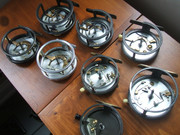
Not wanting to 'lock horns' Clive, I did preface my previous post with 'personally' pertaining, I hoped, to my opinions which followed.
Being a fellow Brit. I grew up with, and am well versed, with coarse fishing and my opinions regarding the Silex clan reach well beyond fly fishing, which I have not really used them for. Tangling with a 36lb Chinook salmon once on a Silex showed me the reels possibilities.
Regarding what 'looks right' is certainly personal (tongue in cheek here) a spinning (fixed spool) reel upside down on top of the rod, being wound backwards also works fine for some.
I see that you have recently joined this forum, you may notice a good deal of 'male jewellery', both rods and reels.
Range of freshwater Silex's featured, in chronological sequence from top left, two first model Silex, Silex 2, a couple of Majors finished off by two 1930's Super Silex including the largest at 4 1/2". The last model from the 1990 with much deleted innards, at the bottom. Only model missing is a Silex Jewell from the 1960's which had some regulator features of the Super Silex which preceded it.
Malcolm
-
Mole-Patrol
- Sport
- Posts: 72
- Joined: 03/17/20 11:41
Re: Hardy Silex
#28The 'personally' part appears to relate to the first paragraph. I don't really see why an angler would be concerned about whether a reel looks right. For me it has to feel right.
I am not really into collecting tackle these days. The rods and reels I buy are either to use for specific purposes or in the case of unusual items that take my fancy, to try and then sell on. As such all my reels have line on them.
I have two Hardys; an Elarex and the Silex Major. The Elarex was bought to pair up with a cane pike rod for a specific type of fishing and the Silex Major was bought specifically for use on a very heavy cane rod where casting would be kept to a minimum. However, without trimming the oversized foot it will not fit on the rod in question so instead I tried it for carp & barbel paired up to a lighter cane rod. In both cases; Elarex and Silex I was prepared to fish them with the 'wrong' hand, but the rear handle on the Silex was a problem that meant that it wasn't suitable for purpose. Curiosity lead me to dismantle the check mechanism and I discovered that it could easily be reversed. As a result of reversing the check I found that the lever was now in the logical place for controlling the cast when holding the rod in the customary 'centrepin' manner. If you are familiar with British types of fishing you would realise how 'wrong' as regards balance it would be to have the lever below the reel. If I could not have turned it around I would have sold the reel on simply because the lever was in the wrong place for my type of fishing.
After a few sessions and a few mid teen carp plus a finger burning catfish I realised that it isn't easy to brake the reel using finger pressure alone. In my opinion this reel was never designed for fishing. It was I think primarily designed for casting. If you are aware of the way that tournament casters of the period set up and held their rods then it is obvious why the rear lever is where it is.
Having an enquiring mind and little technical skill I worked out that the felt brake could be replaced by something more substantial and as I already have fly reels with cork disc brakes and a cellar containing a selection of wines it was a logical move to upgrade the brake. That upgrade did not give me as much braking as I required so after a lot of thought I came up with the idea of fitting a spring limiter and used things I have to hand.
The reel now is an absolute pleasure to use for the purpose that I now use it for and I have absolutely no regrets about having made the alterations. In fact I think that Hardy missed a trick.
I am not really into collecting tackle these days. The rods and reels I buy are either to use for specific purposes or in the case of unusual items that take my fancy, to try and then sell on. As such all my reels have line on them.
I have two Hardys; an Elarex and the Silex Major. The Elarex was bought to pair up with a cane pike rod for a specific type of fishing and the Silex Major was bought specifically for use on a very heavy cane rod where casting would be kept to a minimum. However, without trimming the oversized foot it will not fit on the rod in question so instead I tried it for carp & barbel paired up to a lighter cane rod. In both cases; Elarex and Silex I was prepared to fish them with the 'wrong' hand, but the rear handle on the Silex was a problem that meant that it wasn't suitable for purpose. Curiosity lead me to dismantle the check mechanism and I discovered that it could easily be reversed. As a result of reversing the check I found that the lever was now in the logical place for controlling the cast when holding the rod in the customary 'centrepin' manner. If you are familiar with British types of fishing you would realise how 'wrong' as regards balance it would be to have the lever below the reel. If I could not have turned it around I would have sold the reel on simply because the lever was in the wrong place for my type of fishing.
After a few sessions and a few mid teen carp plus a finger burning catfish I realised that it isn't easy to brake the reel using finger pressure alone. In my opinion this reel was never designed for fishing. It was I think primarily designed for casting. If you are aware of the way that tournament casters of the period set up and held their rods then it is obvious why the rear lever is where it is.
Having an enquiring mind and little technical skill I worked out that the felt brake could be replaced by something more substantial and as I already have fly reels with cork disc brakes and a cellar containing a selection of wines it was a logical move to upgrade the brake. That upgrade did not give me as much braking as I required so after a lot of thought I came up with the idea of fitting a spring limiter and used things I have to hand.
The reel now is an absolute pleasure to use for the purpose that I now use it for and I have absolutely no regrets about having made the alterations. In fact I think that Hardy missed a trick.
Regards,
Clive
I walk the paths where no one goes and cast to fish nobody knows
Clive
I walk the paths where no one goes and cast to fish nobody knows
Re: Hardy Silex
#29By way of interest, the Silex reels were designed to be used mounted lower down the handle than centre-pin reels, much the way spey reels are situated on double handed rods today; as artificial 'baits' such as Wagtails and Devon Minnows would be cast out and 'swung', revolving as they did so in the current for (especially) salmon, they were then retrieved at the end of the cast.
The first model Silex was advertised as 'The new form for all kinds of spinning, prawning, and general coarse fishing' in any case, reels of the era (early 1900's) were generally positioned lower down the handle, as were the very earliest 'winches' used in the UK.
There were many catalogue descriptions over the decades of how to cast Silex reels, typically by the lower hand engaging the casting lever behind the reel almost at the button at the end of the corks for most casting leverage. Further up the handle made little sense.
A few Hardy reels have been proved dubious fishing tools, however for a reel to stay in production for the almost 100 years, as the Silex did, and to be still valued and used today, it would be somewhat harsh to claim that Hardy's 'missed a trick' with the reel.
Malcolm
The first model Silex was advertised as 'The new form for all kinds of spinning, prawning, and general coarse fishing' in any case, reels of the era (early 1900's) were generally positioned lower down the handle, as were the very earliest 'winches' used in the UK.
There were many catalogue descriptions over the decades of how to cast Silex reels, typically by the lower hand engaging the casting lever behind the reel almost at the button at the end of the corks for most casting leverage. Further up the handle made little sense.
A few Hardy reels have been proved dubious fishing tools, however for a reel to stay in production for the almost 100 years, as the Silex did, and to be still valued and used today, it would be somewhat harsh to claim that Hardy's 'missed a trick' with the reel.
Malcolm
-
Mole-Patrol
- Sport
- Posts: 72
- Joined: 03/17/20 11:41
Re: Hardy Silex
#30I meant as in not designing a centrepin that could be cast one handed and the fight controlled by one's finger operating a variable drag. They had all the parts to do it. And if they had placed the lever at the front of the reel it could also be used to cast with a trout fly-rod one handed with the line being extended on the forward cast from the free spool by its own weight.
The way a rod was set up for tournament bait casting in the days that the Hardys competed was with the line coming off the reel from the top, i.e. the wrong way to how we usually fish. The reel was mounted low down on the rod as can be seen from the Hardy Murdoch rod that was a popular choice of competitors, and at 90 degrees to the rod rings, that is when the rod rings are facing vertically down, the reel would be in the horizontal with the line running to the first ring from the top of the reel to minimise resistance. Retrieving after the cast was usually done with the reel uppermost and the rings in the horizontal plane.
Legend has it, and I don't know for sure if it is the truth, it took a Yorkshireman by the name of George Waud to make the Silex reel fit for fishing. Mr. Waud took a hacksaw to his expensive reel and cut a chunk out of it so as he could use finger pressure on the Silex spool. Hardy later offered it as an option and would modify owner's reels that had not got the cut out. So it shouldn't come as a surprise when another Yorkshireman further adapts the reel to make it better for his own purpose.
The way a rod was set up for tournament bait casting in the days that the Hardys competed was with the line coming off the reel from the top, i.e. the wrong way to how we usually fish. The reel was mounted low down on the rod as can be seen from the Hardy Murdoch rod that was a popular choice of competitors, and at 90 degrees to the rod rings, that is when the rod rings are facing vertically down, the reel would be in the horizontal with the line running to the first ring from the top of the reel to minimise resistance. Retrieving after the cast was usually done with the reel uppermost and the rings in the horizontal plane.
Legend has it, and I don't know for sure if it is the truth, it took a Yorkshireman by the name of George Waud to make the Silex reel fit for fishing. Mr. Waud took a hacksaw to his expensive reel and cut a chunk out of it so as he could use finger pressure on the Silex spool. Hardy later offered it as an option and would modify owner's reels that had not got the cut out. So it shouldn't come as a surprise when another Yorkshireman further adapts the reel to make it better for his own purpose.
Regards,
Clive
I walk the paths where no one goes and cast to fish nobody knows
Clive
I walk the paths where no one goes and cast to fish nobody knows
Re: Hardy Silex
#31Not sure of the Yorkshireman legend, as Hardys offered their first model Silex in 1899 with a cut out of almost half the frame in their advertising, although quarter removed (see my example top left previous photos), a feature which continued through to the first incarnation of the Silex 2 which came along around 1911. The frame became enclosed with the Major's which were introduced in 1924. The Super's had exposed rims.
Catalogues from the 1930's show a photo of general manager L.R Hardy in his boat fishing a Silex under the rod;indeed the convoluted diagram of how to cast the first model Silex (1899) shows it 2/3 down the handle, also under the rod.
Looking at the 1937 catalogue of the 'Murdoch' rod with Super Silex attached it being 2/3 down the handle, the rings are lined up with the reel as indeed were the 'Wee Murdoch' rod rings to the reel on the page opposite.
There was a multipling Silex made during the 30's which was cast and used on top of the rod. Scroll back in this thread to see an example. A wider rear button would be depressed to cast, similar to modern baitcasting/ multiplier reels.
On that note, as they say, I rest my case.
Malcolm
Catalogues from the 1930's show a photo of general manager L.R Hardy in his boat fishing a Silex under the rod;indeed the convoluted diagram of how to cast the first model Silex (1899) shows it 2/3 down the handle, also under the rod.
Looking at the 1937 catalogue of the 'Murdoch' rod with Super Silex attached it being 2/3 down the handle, the rings are lined up with the reel as indeed were the 'Wee Murdoch' rod rings to the reel on the page opposite.
There was a multipling Silex made during the 30's which was cast and used on top of the rod. Scroll back in this thread to see an example. A wider rear button would be depressed to cast, similar to modern baitcasting/ multiplier reels.
On that note, as they say, I rest my case.
Malcolm
-
Mole-Patrol
- Sport
- Posts: 72
- Joined: 03/17/20 11:41
Re: Hardy Silex
#32None of your examples refer to the matter of tournament casting which is what I was clearly describing.
"
"
In other editions there are comments from the correspondent of his dismay that none of the outfits used by the successful tournament casters would be any good for the purpose of landing fish should they ever hook one.Supplement to The Fishing Gazette, November 14th to December 26th, 1908
Position of the Reel.
The reel should be placed above the hand in
such a way that the handles are on the Up when the
rod is held rings downwards, but with the line
wound on the reverse way, so that it comes off the
spool on the side next to the rod. In reeling in
after the cast, the rod is held rings uppermost, so
that the handle of the reel can be turned away from
the body with the right hand in the ordinary way. "
Regards,
Clive
I walk the paths where no one goes and cast to fish nobody knows
Clive
I walk the paths where no one goes and cast to fish nobody knows
Re: Hardy Silex
#33I am sure tournament casters got up to all sorts to increase distance. The Silex is a Hardy reel however, and nowhere in their catalogues (that I have seen, and they wrote in depth on their Silex over the years) do they advocate casting or fishing by attaching the Silex on top of the rod with rings the opposite direction. As previously mentioned they did produce a smaller multiplying Silex for fishing on top of the rod, not suitable for tournament I would have thought; Drewetts book features those which were.
Supposedly, if a reel is not deemed suitable for your task, the best thing is to chose another reel which would be, rather than (personally speaking) modifying it and still criticising it.
The Hardy Murdock rod and Silex reel were mentioned as being popular for tournament casting but (implied ) would be not 'any good for the purpose of landing fish should they ever hook one'. No mention in Gazette quotes of specifically Hardy tackle..
Seems that someone managed a good one nonetheless in 1928, when a 250lb 'Goouch'.. was landed in India on a Hardy Murdock rod and a Silex reel.
I have managed dozens of large fast running fish on Silex's over the years, in their various incarnations they remain beautifully made and pleasurable to fish. Having made bamboo rods to match certain Silex models I look forward to attempt learning to cast directly off one, plus discover any advantages there may be for double handed spey type casting.
Malcolm
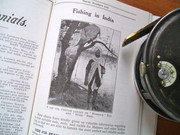

Supposedly, if a reel is not deemed suitable for your task, the best thing is to chose another reel which would be, rather than (personally speaking) modifying it and still criticising it.
The Hardy Murdock rod and Silex reel were mentioned as being popular for tournament casting but (implied ) would be not 'any good for the purpose of landing fish should they ever hook one'. No mention in Gazette quotes of specifically Hardy tackle..
Seems that someone managed a good one nonetheless in 1928, when a 250lb 'Goouch'.. was landed in India on a Hardy Murdock rod and a Silex reel.
I have managed dozens of large fast running fish on Silex's over the years, in their various incarnations they remain beautifully made and pleasurable to fish. Having made bamboo rods to match certain Silex models I look forward to attempt learning to cast directly off one, plus discover any advantages there may be for double handed spey type casting.
Malcolm


-
Mole-Patrol
- Sport
- Posts: 72
- Joined: 03/17/20 11:41
Re: Hardy Silex
#34You are getting mixed up Malcolm.
The tournament casters mounted their reels handles up, not uppermost. As I described previously, the reels were at 90 degrees to how we would expect them to be fished. If you spin one of your Silex reels in the normal fishing position and then repeat with the reel horizontal, handles up, the reel will invariably spin for longer. That is why tournament casters either altered the reel fitting or if wealthy enough or owned the factory, they ordered a custom rod specifically for tournament casting.
The correspondent bemoans the way that rods and reels are set up for casting making them unsuitable for fishing. He suggested holding different classes of competition to include tackle set up as per for fishing. I am sure that the anglers in your example did not have their reel mounted on the side or top of the rod with the line coming off the foot side of the reel.
The Silex Major is not an easy reel to brake with your finger or thumb. I have been casting in the garden with it today and also tried various holds and methods of braking the spool. It simply is not feasible for me on that reel. If it had a cut out then I would agree with you, but it hasn't. Similarly I would not feel comfortable fishing with a rod like the Murdoch and its old-fashioned low reel position. I fish for wels catfish or silure as the French call them and have landed fish to over 75lb using a modern centrepin with a disc brake. I have also had my fingers burnt trying to stop similar fish using finger pressure on reels like the Speedia. The Silex Major does not offer the same size braking area as the Speedia so the problem would be compounded.
However, with my modifications the Silex now really is a pleasant tool to use and I am looking forward to using it against carp and catfish for many years once the lock down is lifted. Your comments about the modification lowering the reel's value and 'not looking as good' are not valid. I value a reel in what use it is, not how it looks, and have no plans to sell it on.
The tournament casters mounted their reels handles up, not uppermost. As I described previously, the reels were at 90 degrees to how we would expect them to be fished. If you spin one of your Silex reels in the normal fishing position and then repeat with the reel horizontal, handles up, the reel will invariably spin for longer. That is why tournament casters either altered the reel fitting or if wealthy enough or owned the factory, they ordered a custom rod specifically for tournament casting.
The correspondent bemoans the way that rods and reels are set up for casting making them unsuitable for fishing. He suggested holding different classes of competition to include tackle set up as per for fishing. I am sure that the anglers in your example did not have their reel mounted on the side or top of the rod with the line coming off the foot side of the reel.
The Silex Major is not an easy reel to brake with your finger or thumb. I have been casting in the garden with it today and also tried various holds and methods of braking the spool. It simply is not feasible for me on that reel. If it had a cut out then I would agree with you, but it hasn't. Similarly I would not feel comfortable fishing with a rod like the Murdoch and its old-fashioned low reel position. I fish for wels catfish or silure as the French call them and have landed fish to over 75lb using a modern centrepin with a disc brake. I have also had my fingers burnt trying to stop similar fish using finger pressure on reels like the Speedia. The Silex Major does not offer the same size braking area as the Speedia so the problem would be compounded.
However, with my modifications the Silex now really is a pleasant tool to use and I am looking forward to using it against carp and catfish for many years once the lock down is lifted. Your comments about the modification lowering the reel's value and 'not looking as good' are not valid. I value a reel in what use it is, not how it looks, and have no plans to sell it on.
Regards,
Clive
I walk the paths where no one goes and cast to fish nobody knows
Clive
I walk the paths where no one goes and cast to fish nobody knows
Re: Hardy Silex
#35// The Hardy Silex Jewel were made from 1954 to 1959 only. The Hardy Silex Jewel are rare Hardy-reels, at least here in Europe, may be its easier to come by a sample in Canada ( the big market for the Hardy Silex after the 1930 th. I think ) Her,s a couple of pictures of a 4" Hardy Silex Jewel made by Hardy reel-maker RMS ( Robert Marshall Scott reel-maker at Hardys between 1916 and 1967 ) After the Hardy Silex Jewel Hardy made two more Hardy Silex models; The Hardy Silex Superba 1961-1971 and from 1972-1996 a Hardy Silex just called the Hardy Silex, both reel-models had a very little complicated mechanisms inside. // Steenoddsnrods wrote:
Not wanting to 'lock horns' Clive, I did preface my previous post with 'personally' pertaining, I hoped, to my opinions which followed.
Being a fellow Brit. I grew up with, and am well versed, with coarse fishing and my opinions regarding the Silex clan reach well beyond fly fishing, which I have not really used them for. Tangling with a 36lb Chinook salmon once on a Silex showed me the reels possibilities.
Regarding what 'looks right' is certainly personal (tongue in cheek here) a spinning (fixed spool) reel upside down on top of the rod, being wound backwards also works fine for some.
I see that you have recently joined this forum, you may notice a good deal of 'male jewellery', both rods and reels.
Range of freshwater Silex's featured, in chronological sequence from top left, two first model Silex, Silex 2, a couple of Majors finished off by two 1930's Super Silex including the largest at 4 1/2". The last model from the 1990 with much deleted innards, at the bottom. Only model missing is a Silex Jewell from the 1960's which had some regulator features of the Super Silex which preceded it.
Malcolm
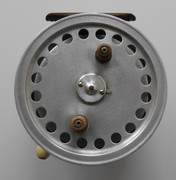
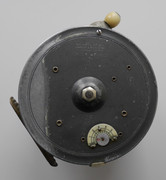
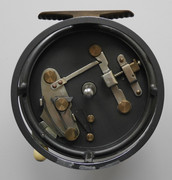

Re: Hardy Silex
#36I forgot I had a Silex Superba.. here new in the box with typed instructions. The innards are simpler, not quite as 'minimal' as the last model would be; the handles are quite close together and the spool/ drum seems relatively heavy in comparison to earlier models.
Malcolm

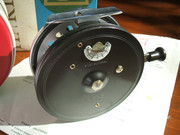
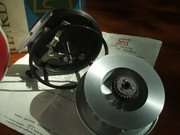
Malcolm



Last edited by oddsnrods on 03/22/20 10:12, edited 3 times in total.
-
Mole-Patrol
- Sport
- Posts: 72
- Joined: 03/17/20 11:41
Re: Hardy Silex
#37I don't know about the various Silex models but one thing that did leap out of those old magazine articles:
I am pretty sure that these tournaments shaped many of Hardy's reels including the one designed for fishing on top of the rod. There was a class for overhead casting and I would imagine that this reel may have been designed especially for that event. There wouldn't have been many cane rods available in those days that could handle the twist employed to a rod under the load of a big fish when the reel was mounted on top.
That reel won five gold medals in the Anglo-French tournament, the only reel to win more than one medal.From Fishing Gazette January – June 1904
The " Silex," another of their marvellous reels, is
in such demand that the firm has difficulty in
supplying it fast enough. Moreover, it also
has been improved. The spindle is now run
on jewelled bearings,
I am pretty sure that these tournaments shaped many of Hardy's reels including the one designed for fishing on top of the rod. There was a class for overhead casting and I would imagine that this reel may have been designed especially for that event. There wouldn't have been many cane rods available in those days that could handle the twist employed to a rod under the load of a big fish when the reel was mounted on top.
Regards,
Clive
I walk the paths where no one goes and cast to fish nobody knows
Clive
I walk the paths where no one goes and cast to fish nobody knows
Re: Hardy Silex
#38Drewetts book provides a wealth of insights into Hardys tournament casting, devoting a chapter to it plus illustrating the line of reels made specifically for this work, these were mostly non-production models, including 4 3/4" The Silex Tournament Reel made during the latter half of 1904 or 1905, with same free-spool lever positioned at the rear edge of the frame for casting as their production model.
The first production Silex had come along 7 years previously, in 1897.
Could you specify which of Hardy's tournament reels was 'designed for fishing on top of the rod', apart from the free-spool models: Jock Scott, Elarex etc. so I may look it up.
Malcolm
The first production Silex had come along 7 years previously, in 1897.
Could you specify which of Hardy's tournament reels was 'designed for fishing on top of the rod', apart from the free-spool models: Jock Scott, Elarex etc. so I may look it up.
Malcolm
-
Mole-Patrol
- Sport
- Posts: 72
- Joined: 03/17/20 11:41
Re: Hardy Silex
#39The Silex multiplier from around 1924 was designed for fishing on top of the rod and once the spool was disengaged it would probably have had less inertia than the conventional Silex spool.
Regards,
Clive
I walk the paths where no one goes and cast to fish nobody knows
Clive
I walk the paths where no one goes and cast to fish nobody knows
Re: Hardy Silex
#40I thought possibly another model apart from the top of the rod production Hardy baitcasters/ multipliers which are well known.
The production Super Silex multiplier seems not to have been used for tournament however, they did make a larger 3 1/8" diameter version called the HM series, a one off, for casting heavier weights.
Drewetts book, well worth referring to.
Malcolm
The production Super Silex multiplier seems not to have been used for tournament however, they did make a larger 3 1/8" diameter version called the HM series, a one off, for casting heavier weights.
Drewetts book, well worth referring to.
Malcolm

